Properties of a Three-Component Mineral Road Binder for Deep-Cold Recycling Technology
Abstract
1. Introduction
2. Materials and Methods
2.1. Properties of the Components Used in the Binder Preparation
2.2. Methodology
2.2.1. Experimental Plan
2.2.2. Paste and Mortar
3. Test Results of Binder Physical and Mechanical Properties
3.1. Determination of the Density, Specific Surface, Proper Amount of Water, and Setting Time of Binders
3.2. Determining the Mortar Consistency
3.3. Test Results of Mortar Compressive and Flexural Strengths
4. Discussion
5. Conclusions
- An appropriate combination of hydraulic road binder components resulted in the optimal composition for the required mechanical and physical performance in the recycled base course layer.
- An addition of CBPD and hydrated lime to Portland cement allowed for obtaining a mineral road binder class N1 to N3 that met the requirements of EN 13282 2: 2015.
- The presence of CBPD in the mineral binder increased its water demand and volume during setting. It also caused the potassium chloride crystallization that occurred after the binder had set, which was manifested by the formation of a white deposit on the mortar surface.
- The presence of hydrated lime contributed primarily to the extended setting time and reduced the flexural and compressive strength of the mortar.
- The Portland cement content was the primary factor that increased the strength of the cement-lime-CBPD mortar.
- The replacement of Portland cement with 50% hydrated lime and CBPD ensured maintaining the required physical and mechanical properties, as demonstrated by the optimization of the hydraulic road binder composition. For road binder production, the CBPD should not be used in an amount greater than 40% of the binder mass.
- The presence of CBPD reduced the strength of the mortars due to KCl recrystallization.
Author Contributions
Funding
Conflicts of Interest
References
- Buczyński, P.; Iwański, M. The Influence of a Polymer Powder on the Properties of a Cold-Recycled Mixture with Foamed Bitumen. Materials 2019, 12, 4244. [Google Scholar] [CrossRef] [PubMed]
- Iwański, M.; Chomicz-Kowlaska, A. Laboratory Study on Mechanical Parameters of Foamed Bitumen Mixture in the Cold Recycling Technology. Procedia Eng. 2013, 57, 433–442. [Google Scholar] [CrossRef]
- Iwański, M.; Chomicz-Kowalska, A. Application of the Foamed Bitumen and Bitumen Emulsion to the Road Base Mixes in the Deep Cold Recycling Technology. Baltic J. Road Bridge Eng. 2016, 11, 93–101. [Google Scholar] [CrossRef]
- Iwański, M.; Buczyński, P.; Mazurek, G. The use of gabbroic dust in the cold recycling of asphalt paving mixes with foamed bitumen. Bull. Pol. Acad. Sci. Tech. Sci. 2016, 64, 763–773. [Google Scholar] [CrossRef]
- Chomicz-Kowalska, A.; Maciejewski, K. Performance and viscoelastic assement of high-recyle rate cold foamed bitumen mixtures produced with different penetration binders for rehabilitation of deteriorated pavements. J. Clean. Prod. 2020, 23, 120517. [Google Scholar] [CrossRef]
- Kukiełka, J. Deep cold recycling on local asphalt road. Materiały Budowlane 2014, 12, 11–13. [Google Scholar]
- Judycki, J.; Dołżycki, B.; Hunik, K.; Stienss, M. Weryfikacja Zasad Projektowania Mieszanek Mineralno-Cementowo-Emulsyjnych; Gdańsk Univeristy of Technology: Gdańsk, Poland, 2006; pp. 7–48. [Google Scholar]
- Barnat-Hunek, D.; Góra, J.; Suchorab, Z.; Łagód, G. 5—Cement kiln dust. In Waste and Supplementary Cementitious Materials in Concrete: Characterization, Properties and Applications; Sissique, R., Cachim, P., Eds.; Woodhead Publishing: Cambridge, UK, 2018; pp. 149–180. [Google Scholar] [CrossRef]
- Czapik, P.; Zapała-Sławeta, J.; Owsiak, Z.; Stępień, P. Hydration of cement by-pass dust. Constr. Build Mat. 2020, 231, 117139. [Google Scholar] [CrossRef]
- Iwański, M.; Buczyński, P.; Mazurek, G. Optimization of the road binder in the layer the road construction. Constr. Build Mat. 2016, 125, 1044–1054. [Google Scholar] [CrossRef]
- Nocuń-Wczelik, W.; Stolarska, K. Calorimetry in the studies of by-pass cement kiln dust as an additive to the calcium aluminate cement. J. Therm. Anal. Calorim. 2019, 138, 4561–4569. [Google Scholar] [CrossRef]
- Owsiak, Z.; Czapik, P.; Zapała-Sławeta, J. Testing the cement, hydrated lime and cement by-pass dust mixtures hydration. Roads Bridges—Drogi i Mosty 2020, 19, 135–147. [Google Scholar] [CrossRef]
- Peethamparan, S.; Olek, J.; Lovell, J. Influence of chemical and Physical characteristics of cement kiln dusts (CKDs) on their hydration behavior and potential suitability for soil stabilization. Cem. Concr. Res. 2008, 38, 803–815. [Google Scholar] [CrossRef]
- Stryczek, S.; Gonet, A.; Czapik, P. Developing technological properties of sealing slurries with the use of cement dust. AGH Drill. Oil Gas 2009, 26, 345–354. [Google Scholar]
- Seo, M.; Lee, S.-Y.; Lee, C.; Cho, S.-S. Recycling of Cement Kiln Dust as Raw Material for Cement. Environments 2019, 6, 113. [Google Scholar] [CrossRef]
- Adaska, W.S.; Taubert, D.H. Beneficial Uses of Cement Kiln Dust. In Proceedings of the 2008 IEEE Cement Industry Technical Conference Record, Miami, FL, USA, 18–28 May 2008. [Google Scholar] [CrossRef]
- Sreekrishnavilasam, A.; Santagata, M.C. Report No. FHWA/IN/JTRP-2005/10 Development of Criteria for the Utilization of Cement Kiln Dust (CKD) in Highway Infrastructures; Joint Transportation Research Program; Purdue University: West Lafayette, IN, USA, 2006. [Google Scholar]
- 2012—INFORMATOR SPC—Przemysł Cementowy w liczbach”, Polish Cement Association reports. Available online: https://www.polskicement.pl/2012-informator-spc-przemysl-cementowy-w-liczbach/ (accessed on 27 July 2020).
- Abdel-Ghani, N.T.; El-Sayed, H.A.; El-Habak, A.A. Utilization of by-pass cement kiln dust and air-cooled blast-furnace steel slag in the production of some “green” cement products. HBRC J. 2018, 14, 408–414. [Google Scholar] [CrossRef]
- Darweesh, H.H.M. A Review Article on the Influence of the Electrostatic Precipitator Cement Kiln Dust Waste on the Environment and Public Health. Am. J. Biol. Environ. Stat. 2017, 3, 36–43. [Google Scholar] [CrossRef][Green Version]
- Taha, R.; Al-Rawas, A.; Al-Harthy, A.; Qatan, A. Use of Cement Bypass Dust as Filler in Asphalt Concrete Mixture. J. Mater. Civil Eng. 2002, 14, 338–343. [Google Scholar] [CrossRef]
- Khater, G.A. Use of bypass cement dust for production of glass ceramic materials. Adv. Appl. Ceram. 2006, 105, 107–111. [Google Scholar] [CrossRef]
- Uliasz-Bocheńczyk, A. Chemical characteristics of dust from cement kilns. Gospod. Surowcami Min. 2019, 35, 87–102. [Google Scholar] [CrossRef]
- 2019—Informator SPC—Przemysł Cementowy w iczbach, Polish Cement Association reports. Available online: https://www.polskicement.pl/2019-informator-spc-przemysl-cementowy-w-liczbach/ (accessed on 27 July 2020).
- Siddique, R. Utilization of cement kiln dust (CKD) in cement mortar and concrete-an overview. Resour. Conserv. Recycl. 2006, 48, 315–338. [Google Scholar] [CrossRef]
- Orešković, M.; Trifunović, S.; Mladenović, G. Use of hydrated lime and cement bypass dust as alternative fillers in hot mix asphalt. In Proceedings of the 17th Colloquium Asphalt, Bitumen and Pavements, Bled, Slovenia, 27–29 November 2019. [Google Scholar]
- Khodary, F.; Abd El-Sadek, M.S.; El-Shestawy, H.S. Nano-Size Cement Bypass as Asphalt Modifier in Highway Construction. Int. J. Eng. Res. Appl. 2013, 3, 645–648. [Google Scholar]
- Buczyński, P.; Iwański, M. The Influence of Hydrated Lime, Portland Cement and Cement Dust on Rheological Properties of Recycled Cold Mixes with Foamed Bitumen. In Proceedings of the “Environmental Engineering” 10th International Conference, Vilnus, Lithuania, 27–28 April 2017. [Google Scholar] [CrossRef]
- Buczyński, P.; Iwański, M.; Mazurek, G. The water resistance of a recycled base with foamed bitumen in the aspect of road binder composition. Bud. Arch. 2016, 15, 19–29. [Google Scholar] [CrossRef]
- Omrani, M.A.; Modarres, A. Emulsified cold recycled mixtures using cement kiln dust and coal waste ash-mechanical-environmental impacts. J. Clean. Prod. 2018, 199, 101–111. [Google Scholar] [CrossRef]
- Bahar, R.; Benazzoug, M.; Kenai, S. Performance of compacted cement-stabilised soil. Cem. Concr. Compos. 2004, 26, 811–820. [Google Scholar] [CrossRef]
- Mahamedi, A.; Khemissa, M. Stabilization of an expansive overconsolidated clay using hydraulic binders. HBRC J. 2015, 11, 82–90. [Google Scholar] [CrossRef][Green Version]
- Pérez, P.; Agrela, F.; Herrador, R.; Ordoñez, J. Application of cement-treated recycled materials in the construction of a section of road in Malaga, Spain. Constr. Build. Mat. 2013, 44, 593–599. [Google Scholar] [CrossRef]
- Pizon, J.; Łaźniewska-Piekarczyk, B. Efficiency assessment of admixtures and cement kiln dust with cooperation with different phase composition slag blended cements. IOP Conf. Ser. Mater. Sci. Eng. 2019, 603, 032088. [Google Scholar] [CrossRef]
- Czarnecki, L.; Kurdowski, W. Tendencje kształtujące przyszłość betonu. Budownictwo Technologie Architektura 2007, 1, 50–55. [Google Scholar]
- Atkinson, A.C.; Donev, A.N. Optimum Experimental Designs, Oxford Science Publications; Clarendon Press: Oxford, UK, 1992. [Google Scholar]
- Polish Committee for Standardization. Hydraulic Road Binders. Normal Hardening Hydraulic Road Binders. Composition, Specifications and Conformity Criteria; PN-EN 13282-2:2015; Polish Committee for Standardization: Warsaw, Poland, 2015. [Google Scholar]
- Lazić, Ž.R. Design of Experiments in Chemical Engineering: A Practical Guide; Wiley-VCH: Weinheim, Germany, 2004. [Google Scholar]
- Polish Committee for Standardization. Methods of Testing Cement. Chemical Analysis of Cement; PN-EN 196-2:2013; Polish Committee for Standardization: Warsaw, Poland, 2013. [Google Scholar]
- Polish Committee for Standardization. Methods of Testing Cement. Determination of Setting Times and Soundness; PN-EN 196-3:2016; Polish Committee for Standardization: Warsaw, Poland, 2016. [Google Scholar]
- Polish Committee for Standardization. Methods of Testing Cement. Determination of Fineness; PN-EN 196-6:2018; Polish Committee for Standardization: Warsaw, Poland, 2018. [Google Scholar]
- Polish Committee for Standardization. Building Mortars—Testing of Physical and Mechanical Properties; PN 85/B-04500; Polish Committee for Standardization: Warsaw, Poland, 1985. [Google Scholar]
- Polish Committee for Standardization. Methods of Test for Mortar for Masonry. Determination of Consistence of Fresh Mortar (by Flow Table); PN-EN 1015-3:2000/A1:2005; Polish Committee for Standardization: Warsaw, Poland, 2005. [Google Scholar]
- Polish Committee for Standardization. Methods of Testing Cement. Determination of Strength; PN-EN 196-1:2016; Polish Committee for Standardization: Warsaw, Poland, 2016. [Google Scholar]
- Neville, A.M. Properties of Concrete, 5th ed.; Pearson: Harlow, UK, 2011. [Google Scholar]
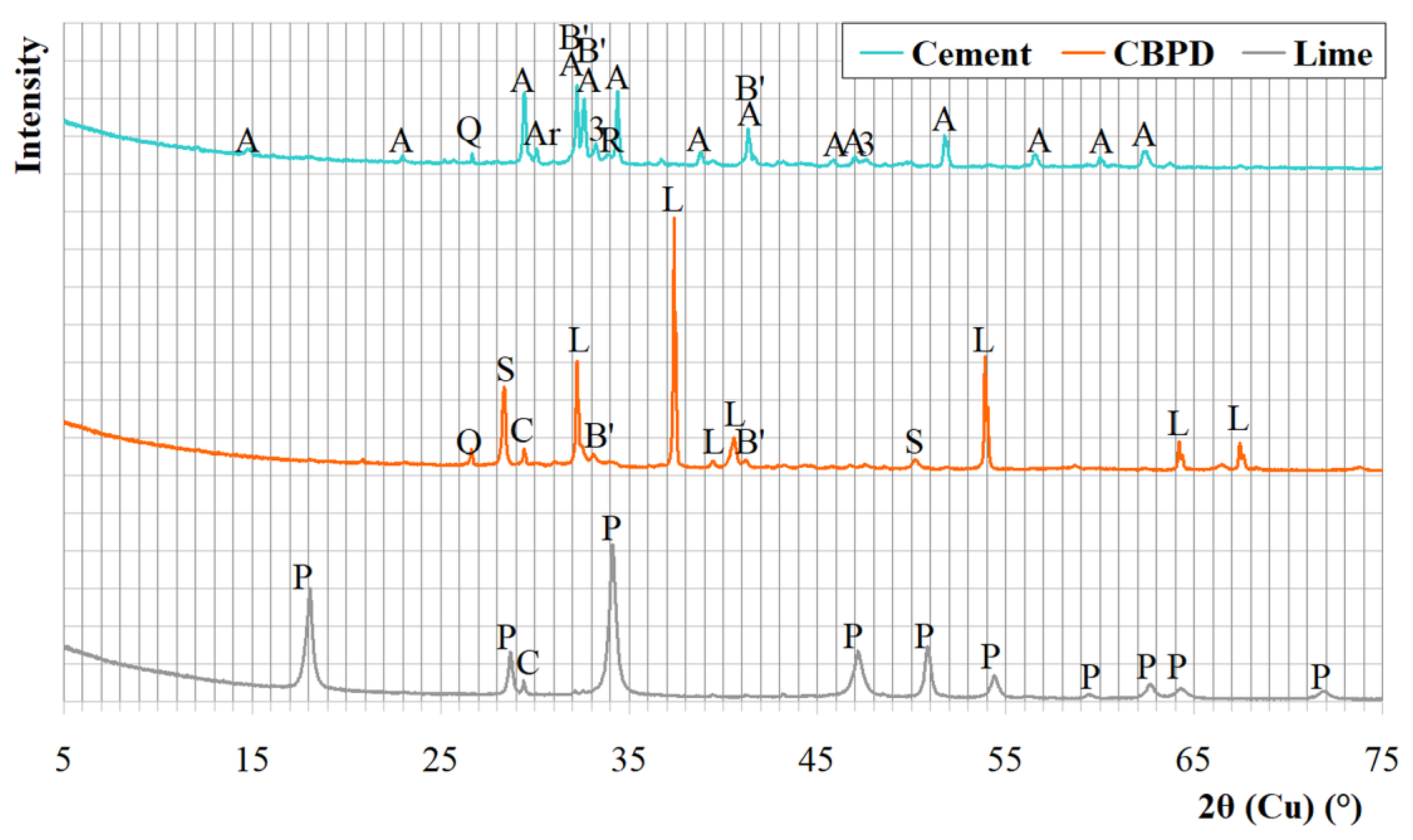

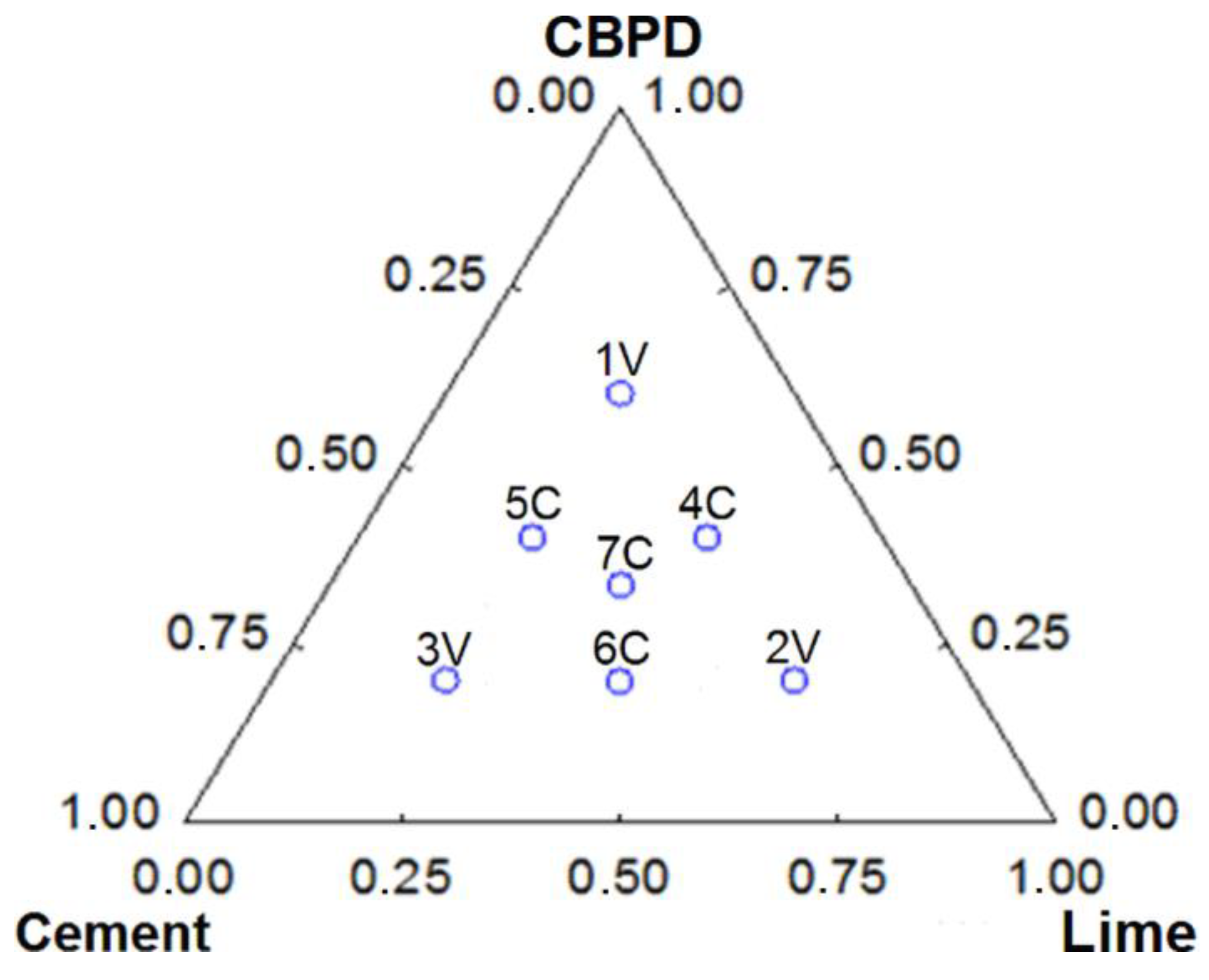
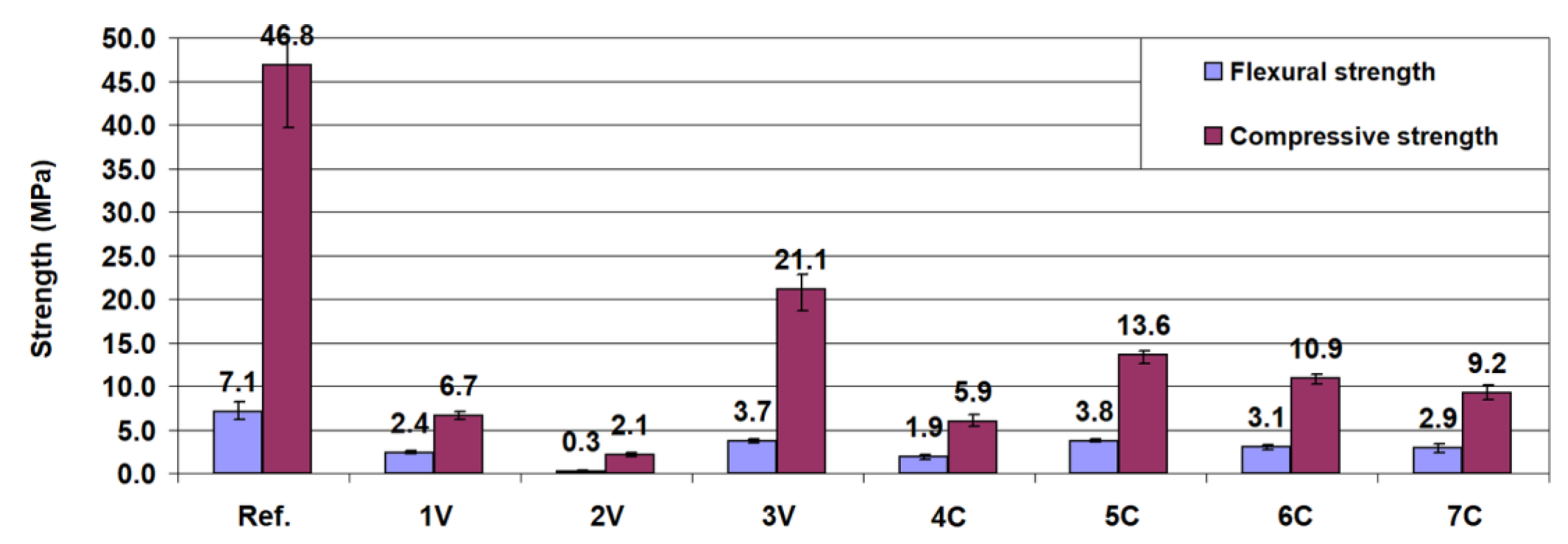
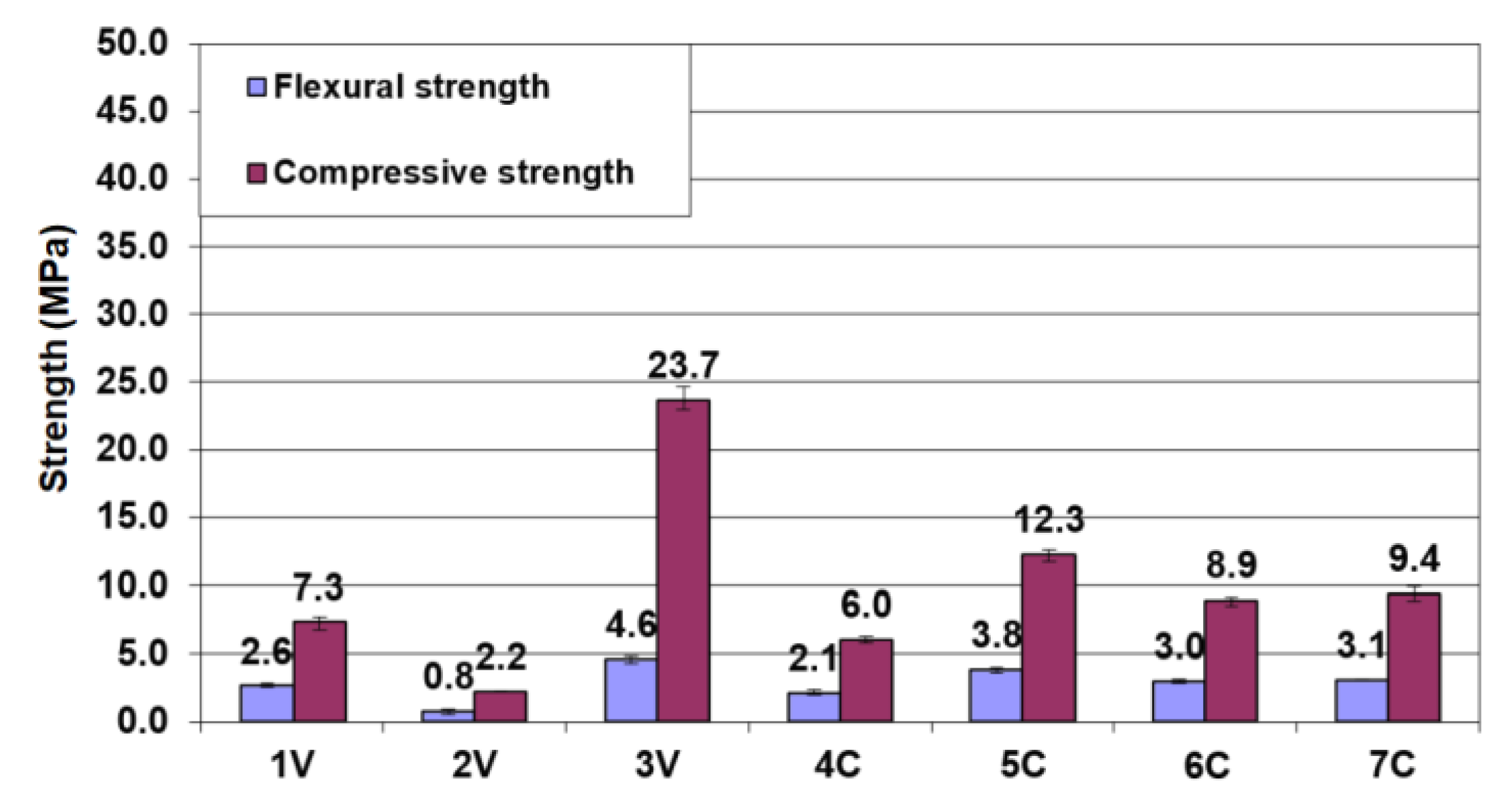
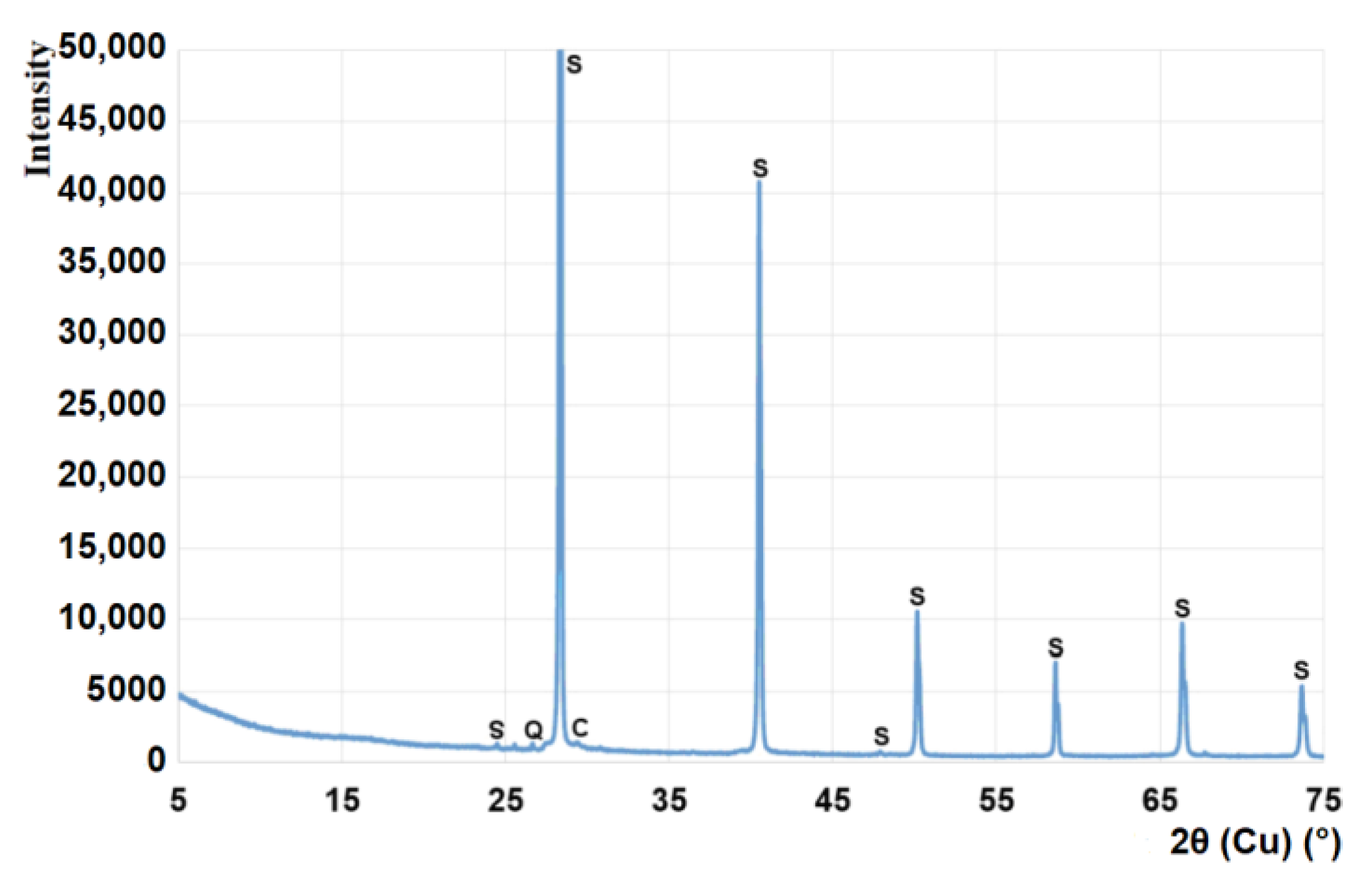
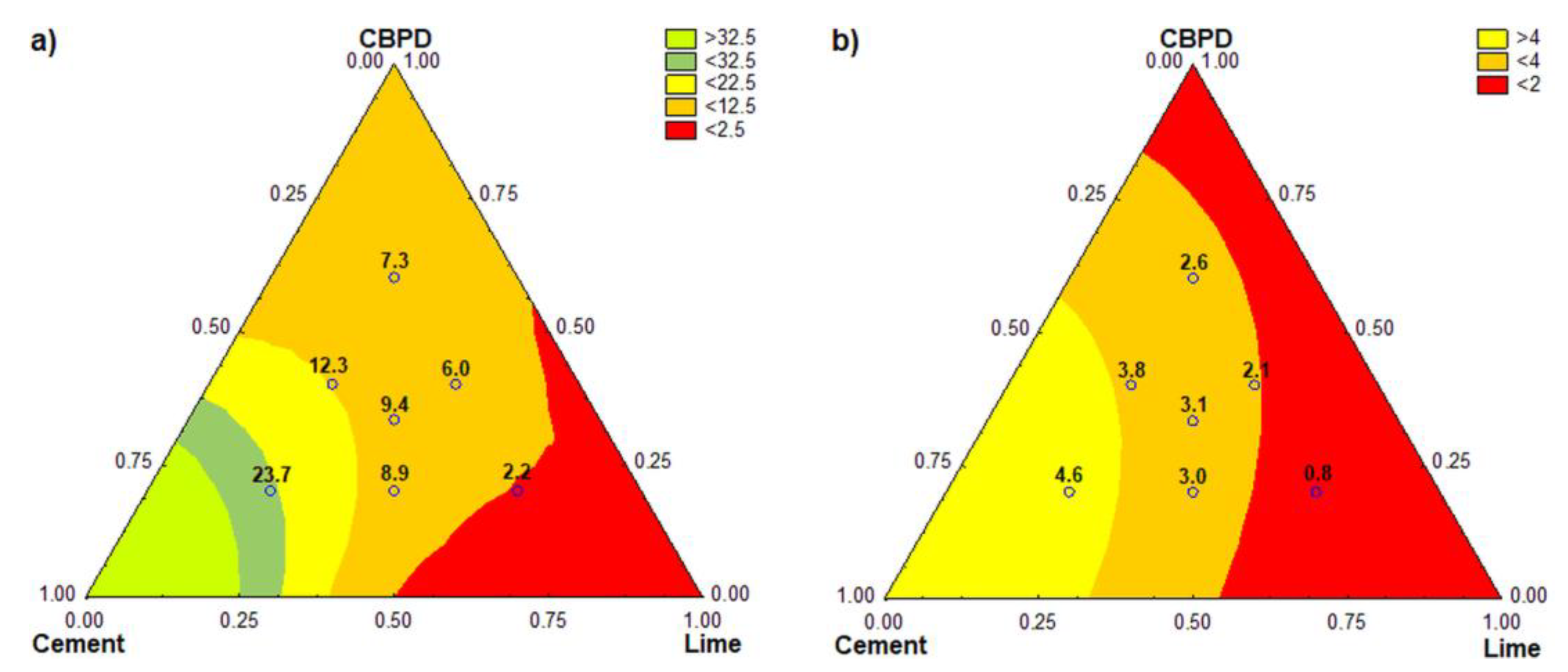
| Material | Content (%) | ||||||||||
|---|---|---|---|---|---|---|---|---|---|---|---|
| SiO2 | Al2O3 | Fe2O3 | CaO | MgO | Na2O | K2O | Na2Oe | Cl | SO3 | LOI | |
| CEM I 32.5R | 19.70 | 4.28 | 2.44 | 64.50 | 1.60 | 0.14 | 0.79 | 0.66 | 0.043 | 3.33 | 3.50 |
| CBPD | 15.44 | 3.42 | 1.77 | 52.17 | 1.31 | 0.26 | 6.03 | 4.22 | 3.53 | 1.65 | 14.40 |
| CEM I 32.5R | CBPD | Lime | |||
|---|---|---|---|---|---|
| C3S (alite) | 65.3 | Free lime | 42.8 | Portlandite | 97.4 |
| β-C2S (belite) | 10.0 | Sylvine | 16.2 | Calcite | 2.6 |
| C4AF | 4.4 | C2S (belite) | 33.3 | ||
| C3A | 9.3 | Calcite | 5.9 | ||
| Arcanite | 1.3 | Quartz | 2.7 | ||
| Gypsum | 1.0 | ||||
| Calcite | 7.7 | ||||
| Quartz | 1.0 | ||||
| Binders | Components | ||
|---|---|---|---|
| Cement | Lime | CBPD | |
| Ref. | 1.00 | 0 | 0 |
| 1V | 0.20 | 0.20 | 0.60 |
| 2V | 0.20 | 0.60 | 0.20 |
| 3V | 0.60 | 0.20 | 0.20 |
| 4C | 0.20 | 0.40 | 0.40 |
| 5C | 0.40 | 0.20 | 0.40 |
| 6C | 0.40 | 0.40 | 0.20 |
| 7C | 0.33 | 0.33 | 0.33 |
| Binder Type | Ref. | 1V | 2V | 3V | 4C | 5C | 6C | 7C |
|---|---|---|---|---|---|---|---|---|
| Density (kg/dm3) | 3.05 | 2.85 | 2.57 | 2.89 | 2.74 | 2.86 | 2.75 | 2.76 |
| Specific area (m3/kg) | 377 | 534 | 576 | 466 | 555 | 501 | 521 | 520 |
| w/b | 0.27 | 0.70 | 0.67 | 0.45 | 0.61 | 0.57 | 0.50 | 0.55 |
| Initial setting time (min) | 200 | 265 | 1050 | 160 | 310 | 265 | 380 | 450 |
| Final setting time (min) | 265 | 305 | 1620 | 190 | 630 | 460 | 710 | 800 |
| Setting time (min) | 65 | 40 | 570 | 30 | 320 | 195 | 330 | 350 |
| Soundness (mm) | 9 | 54 | 22 | 21 | 53 | 17 | 9 | 17 |
| Binders | w/b | Flow Table Test | Penetration Test |
|---|---|---|---|
| (cm) | (cm) | ||
| Ref. | 0.50 | 13.5 | 4.2 |
| 1V | 0.79 | 13.5 | 3.5 |
| 2V | 0.76 | 13.5 | 3.2 |
| 3V | 0.60 | 13.5 | 4.2 |
| 4C | 0.75 | 14.0 | 3.5 |
| 5C | 0.68 | 14.0 | 3.5 |
| 6C | 0.62 | 13.5 | 3.8 |
| 7C | 0.66 | 14.0 | 3.4 |
© 2020 by the authors. Licensee MDPI, Basel, Switzerland. This article is an open access article distributed under the terms and conditions of the Creative Commons Attribution (CC BY) license (http://creativecommons.org/licenses/by/4.0/).
Share and Cite
Owsiak, Z.; Czapik, P.; Zapała-Sławeta, J. Properties of a Three-Component Mineral Road Binder for Deep-Cold Recycling Technology. Materials 2020, 13, 3585. https://doi.org/10.3390/ma13163585
Owsiak Z, Czapik P, Zapała-Sławeta J. Properties of a Three-Component Mineral Road Binder for Deep-Cold Recycling Technology. Materials. 2020; 13(16):3585. https://doi.org/10.3390/ma13163585
Chicago/Turabian StyleOwsiak, Zdzisława, Przemysław Czapik, and Justyna Zapała-Sławeta. 2020. "Properties of a Three-Component Mineral Road Binder for Deep-Cold Recycling Technology" Materials 13, no. 16: 3585. https://doi.org/10.3390/ma13163585
APA StyleOwsiak, Z., Czapik, P., & Zapała-Sławeta, J. (2020). Properties of a Three-Component Mineral Road Binder for Deep-Cold Recycling Technology. Materials, 13(16), 3585. https://doi.org/10.3390/ma13163585





